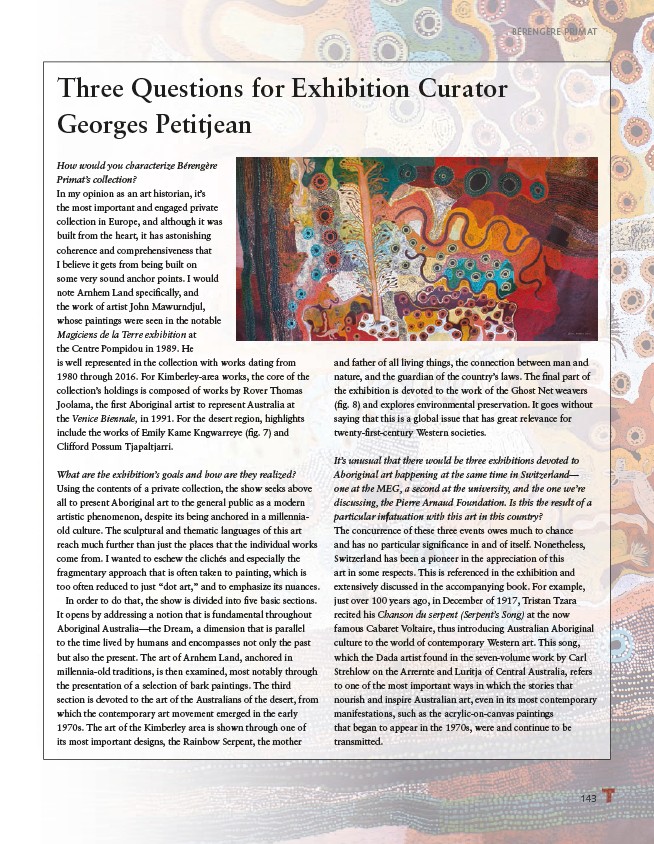
and father of all living things, the connection between man and
nature, and the guardian of the country’s laws. The fi nal part of
the exhibition is devoted to the work of the Ghost Net weavers
(fi g. 8) and explores environmental preservation. It goes without
saying that this is a global issue that has great relevance for
twenty-fi rst-century Western societies.
It’s unusual that there would be three exhibitions devoted to
Aboriginal art happening at the same time in Switzerland—
one at the MEG, a second at the university, and the one we’re
discussing, the Pierre Arnaud Foundation. Is this the result of a
particular infatuation with this art in this country?
The concurrence of these three events owes much to chance
and has no particular signifi cance in and of itself. Nonetheless,
Switzerland has been a pioneer in the appreciation of this
art in some respects. This is referenced in the exhibition and
extensively discussed in the accompanying book. For example,
just over 100 years ago, in December of 1917, Tristan Tzara
recited his Chanson du serpent (Serpent’s Song) at the now
famous Cabaret Voltaire, thus introducing Australian Aboriginal
culture to the world of contemporary Western art. This song,
which the Dada artist found in the seven-volume work by Carl
Strehlow on the Arrernte and Luritja of Central Australia, refers
to one of the most important ways in which the stories that
nourish and inspire Australian art, even in its most contemporary
manifestations, such as the acrylic-on-canvas paintings
that began to appear in the 1970s, were and continue to be
transmitted.
143
Three Questions for Exhibition Curator
Georges Petitjean
How would you characterize Bérengère
Primat’s collection?
In my opinion as an art historian, it’s
the most important and engaged private
collection in Europe, and although it was
built from the heart, it has astonishing
coherence and comprehensiveness that
I believe it gets from being built on
some very sound anchor points. I would
note Arnhem Land specifi cally, and
the work of artist John Mawurndjul,
whose paintings were seen in the notable
Magiciens de la Terre exhibition at
the Centre Pompidou in 1989. He
is well represented in the collection with works dating from
1980 through 2016. For Kimberley-area works, the core of the
collection’s holdings is composed of works by Rover Thomas
Joolama, the fi rst Aboriginal artist to represent Australia at
the Venice Biennale, in 1991. For the desert region, highlights
include the works of Emily Kame Kngwarreye (fi g. 7) and
Clifford Possum Tjapaltjarri.
What are the exhibition’s goals and how are they realized?
Using the contents of a private collection, the show seeks above
all to present Aboriginal art to the general public as a modern
artistic phenomenon, despite its being anchored in a millenniaold
culture. The sculptural and thematic languages of this art
reach much further than just the places that the individual works
come from. I wanted to eschew the clichés and especially the
fragmentary approach that is often taken to painting, which is
too often reduced to just “dot art,” and to emphasize its nuances.
In order to do that, the show is divided into fi ve basic sections.
It opens by addressing a notion that is fundamental throughout
Aboriginal Australia—the Dream, a dimension that is parallel
to the time lived by humans and encompasses not only the past
but also the present. The art of Arnhem Land, anchored in
millennia-old traditions, is then examined, most notably through
the presentation of a selection of bark paintings. The third
section is devoted to the art of the Australians of the desert, from
which the contemporary art movement emerged in the early
1970s. The art of the Kimberley area is shown through one of
its most important designs, the Rainbow Serpent, the mother
BÉRENGÈRE PRIMAT